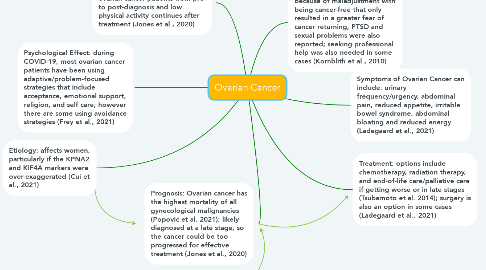Ovarian Cancer
by Makenna Leisure

1. Prognosis: Ovarian cancer has the highest mortality of all gynecological malignancies (Popović et al. 2021); likely diagnosed at a late stage, so the cancer could be too progressed for effective treatment (Jones et al., 2020)
2. Etiology: affects women, particularly if the KPNA2 and KIF4A markers were over-exaggerated (Cui et al., 2021)
3. Psychological Effect: during COVID-19, most ovarian cancer patients have been using adaptive/problem-focused strategies that include acceptance, emotional support, religion, and self care; however there are some using avoidance strategies (Frey et al., 2021)
4. Early Detection: it has been caught in early stages through the use of transvaginal ultrasounds (Ladegaard et al., 2021)
5. Health Behaviors: studies show that physical activity decreases in ovarian cancer patients from pre- to post-diagnosis and low physical activity continues after treatment (Jones et al., 2020)
6. Symptoms of Ovarian Cancer can include: urinary frequency/urgency, abdominal pain, reduced appetite, irritable bowel syndrome, abdominal bloating and reduced energy (Ladegaard et al., 2021)
7. Treatment: options include chemotherapy, radiation therapy, and end-of-life care/palliative care if getting worse or in late stages (Tsubamoto et al. 2014); surgery is also an option in some cases (Ladegaard et al., 2021)
8. Health psychology is needed in some cases of ovarian cancer because of maladjustment with being cancer-free that only resulted in a greater fear of cancer returning; PTSD and sexual problems were also reported; seeking professional help was also needed in some cases (Kornblith et al., 2010)


